Related Research Articles

The University of North Carolina at Greensboro is a public research university in Greensboro, North Carolina. It is part of the University of North Carolina system. It is accredited by the Southern Association of Colleges and Schools Commission on Colleges to award baccalaureate, master's, specialist, and doctoral degrees.

Western Carolina University (WCU) is a public university in Cullowhee, North Carolina. It is part of the University of North Carolina system.
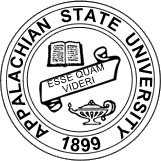
Appalachian State University is a public university in Boone, North Carolina. It was founded as a teachers college in 1899 by brothers B. B. and D. D. Dougherty and the latter's wife, Lillie Shull Dougherty. The university expanded to include other programs in 1967 and joined the University of North Carolina System in 1971.

Emerson College is a private college with its main campus in Boston, Massachusetts. It also maintains campuses in Hollywood, Los Angeles, California and Well, Limburg, Netherlands. Founded in 1880 by Charles Wesley Emerson as a "school of oratory," the college offers more than three dozen degree and professional training programs specializing in the fields of arts and communication with a foundation in liberal arts studies. The college is one of the founding members of the ProArts Consortium, an association of six neighboring institutions in Boston dedicated to arts education at the collegiate level. Emerson is also notable for the college's namesake public opinion poll, Emerson College Polling.
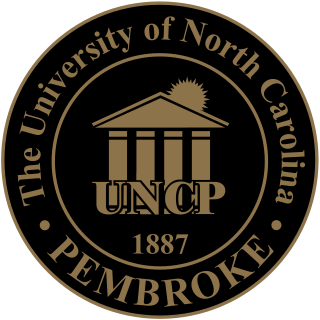
The University of North Carolina at Pembroke is a public university in Pembroke, North Carolina. UNC Pembroke is a master's level degree-granting university and part of the University of North Carolina system. Its history is intertwined with that of the Lumbee nation.
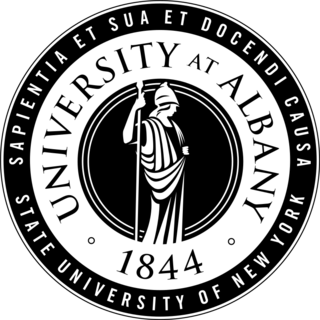
The State University of New York at Albany, commonly referred to as the University at Albany, UAlbany or SUNY Albany, is a public research university with campuses in Albany, Rensselaer, and Guilderland, New York. Founded in 1844, it is one of four "university centers" of the State University of New York (SUNY) system.
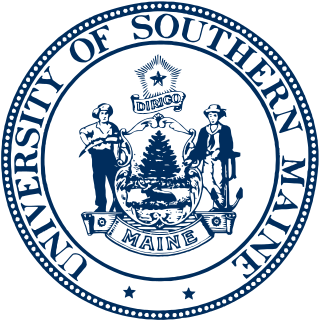
The University of Southern Maine (USM) is a public university with campuses in Portland, Gorham and Lewiston in the U.S. state of Maine. It is the southernmost of the University of Maine System. It was founded as two separate state universities, Gorham Normal School and Portland University. The two universities, later known as Gorham State College and the University of Maine at Portland, were combined in 1970 to help streamline the public university system in Maine and eventually expanded by adding the Lewiston campus in 1988.

Brandon University is a university located in the city of Brandon, Manitoba, Canada, with an enrolment of approximately 3,375 (2020) full-time and part-time undergraduate and graduate students. The current location was founded on July 13, 1899, as Brandon College as a Baptist institution. It was chartered as a university by then President John E. Robbins on June 5, 1967. The enabling legislation is the Brandon University Act. Brandon University is one of several predominantly undergraduate liberal arts and sciences institutions in Canada.

Francis Marion University is a public university near Florence, South Carolina. It is named in honor of American Revolutionary War Brigadier General Francis Marion.

Wesleyan College is a private, liberal arts women's college in Macon, Georgia, United States. Founded in 1836, Wesleyan was the first college in the world chartered to grant degrees to women. It opened in 1839, two years after the opening of Mount Holyoke College.

West Liberty University (WLU) is a public university in West Liberty, West Virginia. It is West Virginia's oldest college or university. It offers more than 70 undergraduate majors plus graduate programs, including a master's degree in education, a physician assistant studies program, and an online MBA. WLU's athletic teams, known as the Hilltoppers, are charter members of the NCAA Division II Mountain East Conference with nearly 400 student-athletes participating in 16 intercollegiate sports, including football, basketball, wrestling, track, acrobatics & tumbling and baseball.

Anderson University is a private Christian university in Anderson, South Carolina. It offers bachelor's, master's, and doctoral degrees in over 100 areas of study. Anderson is affiliated with the South Carolina Baptist Convention and is accredited by the Commission on Colleges of the Southern Association of Colleges and Schools. Anderson participates in NCAA Division II athletics and is a member of the South Atlantic Conference.
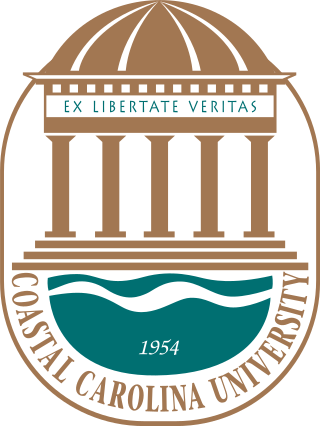
Coastal Carolina University is a public university in Conway, South Carolina. Founded in 1954 as Coastal Carolina Junior College, and later joining the University of South Carolina System as USC Coastal Carolina, it became an independent university in 1993.

Westminster Choir College (WCC) is a historic conservatory of music currently operating on the campus of Rider University in Lawrenceville, New Jersey. Rider's College of Arts and Sciences, the college under which the historic institution has been reorganized, consists of Westminster Choir College as well as three additional schools.
The Henry and Leigh Bienen School of Music is the music and performance arts school of Northwestern University. It is located on Northwestern University's campus in Evanston, Illinois, United States.
Four Schools make up the College of Fine Arts & Communication at East Carolina University. The College was created on July 1, 2003, but has its roots to the beginning of ECU in 1907. The School of Theatre and Dance runs productions by the East Carolina Playhouse and the East Carolina Summer Theatre.

Caldwell Community College and Technical Institute (CCC&TI) is a public community college in Hudson, North Carolina. It serves residents of Caldwell and Watauga counties. CCC&TI is part of the North Carolina Community College System.

The Blair School of Music, located in Nashville, Tennessee, provides a conservatory-caliber undergraduate education in music performance, composition, or integrated music studies within the context of a major research university, Vanderbilt University. Blair also provides music lessons, classes and ensembles to over 800 precollege and adult students each semester. Blair is the youngest and smallest of Vanderbilt's ten constituent schools and colleges.

Wilfred Conwell Bain was an American music educator, a university level music school administrator, and an opera theater director at the collegiate level. Bain is widely credited for rapidly transforming to national prominence both the University of North Texas College of Music as dean from 1938 to 1947, and later, Indiana University School of Music as dean from 1947 to 1973. Both institutions are major comprehensive music schools with the largest and second largest enrollments, respectively, of all music schools accredited by the National Association of Schools of Music. He was born in Shawville, Quebec, and died in Bloomington, Indiana.

The history of East Texas State Teachers College (ETSTC) comprises the history of the university now known as Texas A&M University–Commerce from its renaming as East Texas State Teachers College in 1923 to its renaming as East Texas State College in 1957. During this era, ETSTC was led by four different presidents, two of whom served for more than a decade. The ETSTC period was marked by increasing recognition, notably through obtaining membership in the Southern Association of Colleges and Schools (SACS) in 1925, as well as marked growth in its faculty, student enrollment, and physical plant. ETSTC grew from 65 faculty in 1925 to 132 in 1957, from approximately 1,000 students in 1925 to over 3,000 in 1958–59, and from six buildings valued at roughly $500,000 in the early 1920s to a physical plant valued at over $4 million in 1949.
References
- ↑ "Academics". Hayes School of Music. Appalachian State University. 21 December 2015. Retrieved 3 June 2022.
- ↑ Rodriguez, Sarah. "Lillie Shull Dougherty's Legacy as Co-Founder of Appalachian State". Watauga Democrat. Retrieved 3 June 2022.
- ↑ The Appalachian https://theappalachianonline.com/appalachian-to-sell-dc-house/ . Retrieved March 1, 2023.
{{cite web}}: Missing or empty|title=(help) - ↑ "Undergraduate Degrees". Hayes School of Music. Appalachian State University. 22 December 2015. Retrieved 3 June 2022.
- ↑ "Home". Graduate Programs. Appalachian State University. Retrieved 3 June 2022.
- ↑ "Facilities". Hayes School of Music. Appalachian State University. 21 December 2015. Retrieved 3 June 2022.